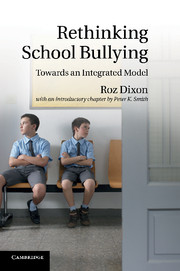Book contents
- Frontmatter
- Contents
- Acknowledgements
- Introduction
- 1 Bullying in schools: the research background
- 2 Understanding schools as systems
- 3 Bullying in groups: ostracism and scapegoating
- 4 Developing an integrated, systemic model of school bullying
- 5 Building personal bodies of knowledge to support research and practice
- 6 Building a public body of knowledge to support research and practice
- 7 Conclusion
- References
- Index
2 - Understanding schools as systems
Published online by Cambridge University Press: 28 April 2011
- Frontmatter
- Contents
- Acknowledgements
- Introduction
- 1 Bullying in schools: the research background
- 2 Understanding schools as systems
- 3 Bullying in groups: ostracism and scapegoating
- 4 Developing an integrated, systemic model of school bullying
- 5 Building personal bodies of knowledge to support research and practice
- 6 Building a public body of knowledge to support research and practice
- 7 Conclusion
- References
- Index
Summary
When faced with complex psychosocial problems such as bullying, it may be useful to adopt a systemic approach in order to understand which parts of the system play an active role, how these parts interact and what can be done. This chapter presents an in-depth case study of one mainstream secondary school. The aim is twofold. First, it demonstrates the complex set of relationships that develops across a school system to meet the needs of students, parents and staff. Second, it illustrates one way of mapping the relationships within which bullying is embedded. The first half of the chapter focuses on dynamics within the student group that resulted in bullying behaviour in this school. These included the pressure to conform, and the pressure to gain and maintain position in the social hierarchy. The process by which day-to-day power struggles evolved into ongoing bully–victim relationships is explored. The particular vulnerability of some children to becoming trapped in an ongoing bullying relationship is discussed. An important feature of this school is that it had a specialist unit for students who were hearing impaired. Detailed consideration is given to the social interactions of these students. Whilst they were rarely subject to serious bullying, their social interactions with other students were complex and often problematic. Like any other child in the school, these students had to be seen to conform and they had to secure and protect their place in the social hierarchy.
- Type
- Chapter
- Information
- Rethinking School BullyingTowards an Integrated Model, pp. 38 - 79Publisher: Cambridge University PressPrint publication year: 2011



